An intrinsic part of the
fight-or-flight response is muscle tension. When muscles tighten, they
also shorten. One way to reverse the fight-or-flight response is to
lengthen your muscles. This is accomplished quite simply by stretching
the muscles. Our goal here is not to provide a comprehensive manual on
stretching exercises, but we would like to teach you several critical
stretches that can help reduce or prevent tension headaches and mention
some guidelines for stretching intuitively.
Intuitive Stretching
As you cultivate
body awareness and relaxation, you will notice an urge to stretch your
body in various ways. Many people notice that yawning is accompanied by
an almost instinctual urge to lean back and extend one's arms. We are
very aware of the need to stretch after sitting in a car or at a desk
for a prolonged period of time. Anyone who has dogs or cats can watch
them stretch when they awaken or when they anticipate they will go for a
walk. While it is a good idea to read a manual on stretching or to take
a yoga class to learn a specific routine, your body is actually a very
good guide to this procedure if you pay attention to it. After all,
someone figured this stuff out without referring to a textbook. Nor has
anyone found the family dog curled up in front of the fireplace with an
autographed copy of The Auto-biography of a Yogi. This information is inside you. The following are guidelines for intuitive stretching:
-
Set up a comfortable environment for your practice. This might include soft music.
-
It is always easier to stretch muscles when they are warm. Thus,
some light exercise such as walking until you begin to break a sweat is
recommended. Another alternative would be to stretch after or while in a
hot shower.
-
Stretch on a firm padded surface, such as an exercise mat.
-
Pay attention to what you are doing. It should not hurt when you
stretch. Pain is a sure signal that you are doing something with too
much intensity or in a direction that your body was not meant to
accommodate. Progress in stretching will come rapidly, within weeks, but
it is accomplished in small, incremental steps. Stretch and move your
body until you feel a solid pull on the muscles and maintain that
position as long as you feel comfortable. Return to your original
position slowly.
-
Move slowly, and do not bounce into any stretch.
-
Do not hold your breath while stretching, but keep your breath
flowing. Visualize or sense your breath carrying oxygen to the areas
being stretched. See and sense them loosening.
-
Rest for a short time after each stretch.
-
At the end of your stretching period, take time to cool down and
relax. An excellent time to do a breathing meditation or progressive
relaxation is following stretching.
-
While it is optimal to do a set stretch routine on a daily basis,
do not limit your stretching to only one time or place. There are many
moments throughout the day—at your desk, stopped in your car, and so
on—when you can relieve the stress and tension in certain muscle groups
with a quick stretch.
Stretches to Reduce or Prevent Tension Headaches
Muscles that are not
strong and flexible tend to spasm and create pain. The muscles that
support the head and neck are difficult to deliberately strengthen.
These muscles are also intensely involved in the fight-or-flight
response, as primates tend to pull their shoulders up to protect their
necks and appear bigger when threatened. Over time, chronic tension
shortens these muscles and leads to tension headaches. We have found
several very simple exercises to be excellent for preventing tension
headaches. These stretching exercises are most easily done in a standing
position, but can also be done while sitting by moving up to the front
edge of a chair or bed. Our favorite place to do this particular set of
exercises is in a warm shower. Please follow the illustrations so that
you stretch safely. Remember, no fast movements and no pain. Begin by
placing both of your hands on your hips with your thumbs in front of
your body and your remaining fingers on your lower back. Next, pull your
shoulders back slightly. You are now in the correct position to begin.
Stretch 1
Fix your eyes on a point
at eye level in front of you. While maintaining that visual anchor, move
your head to the right as if you were attempting to touch your right
ear to your right shoulder, as shown in Figure 1. You will feel the muscles stretching on the left side of your neck and shoulders. Hold this position while breathing for ten to twelve seconds, and then repeat this movement to the left (Figure 2). Repeat the complete sequence three times.
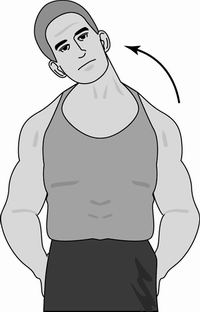
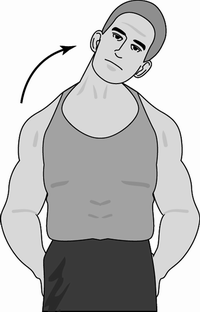
Stretch 2
From the start
position, turn your head to the right as if you are looking over your
shoulder and trying to see something behind you, as shown in Figure 3.
Do not turn from the waist, but swivel your head from the neck up. Turn
as far as you can without pain and hold this position for ten to twelve
seconds while continuing to breathe. Then repeat the motion to the left (Figure 4). Repeat the entire sequence three times.
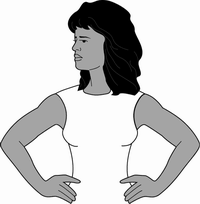
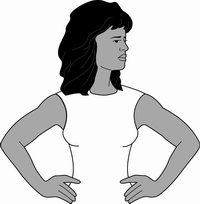
Caution:
If your head should rotate completely around and face forward
again, you should call a priest immediately. You may need an exorcist
instead of stress reduction!
Stretch 3
The third stretch is
clearly the geekiest of the stretches and definitely provokes laughter
whenever we train people in its use. (This is also why we recommend
doing these stretches in the shower.) Beginning from the starting
position, push your face straight out as if you were trying to touch
your nose to a point in space about three inches directly in front of
your nose, as shown in Figure 5.
You will feel the stretch at the back of your head, neck, and
shoulders. You will also look like a chicken pecking for corn! Continue
breathing, even if people are laughing at you. Hold this for ten to
twelve seconds. Then reverse this movement, as if you were trying to
pull your face and nose directly back from a really bad smell (Figure 6).
You will tend to feel this stretch more in front of your neck and
chest. Repeat this three times. You may now get out of the shower.
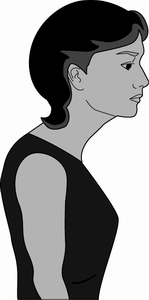
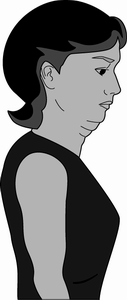
All kidding aside, if you
are prone to muscle tension headaches, regular practice of these
stretches will help elongate, strengthen, and loosen up the muscles in
your head, neck, and shoulders. As a result, you can significantly
decrease the frequency and severity of tension headaches and perhaps
eliminate them altogether.